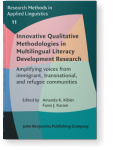Chapter 3
An ethnetnography of (non)belonging
The transliterate practices of a Muslim refugee-background
mother
This chapter aims at presenting ethnetnography as an
innovative qualitative methodology for studying multilingual
literacy practices in Applied Linguistics. An ethnetnography
combines elements of a traditional ethnography with a netnography
(focusing on participants’ online interactions). To showcase how to
conduct an ethnetnography, we draw upon a study that traces how a
Muslim refugee-background participant negotiates (non)belonging
within the resettlement context of the United States. We share how
to collect, analyze, and present the data and reflect on the rewards
and challenges of adopting ethnetnographic methods. Methodological
implications are presented on how an ethnetnographic approach can
provide for a more complete, equitable, and ethical examination of
the literacies of refugee-background individuals on the move.
Article outline
- Introduction
- Overview of the study and its findings
- Context and focal participant
- Theoretical frame
- Relevant literature
- Findings
- Methodological discussion: Rethinking data for more equitable
research
- Netnographies in second language acquisition research
- Ethnetnography: Towards a definition
- Researcher positionality, recruitment, and ethical
considerations
- Ethnetnographic data collection operations
- Ethnetnographic data analysis
- Rewards, challenges, and limitations
- Implications for qualitative research on multilingual literacy
development
-
References
This content is being prepared for publication; it may be subject to changes.
